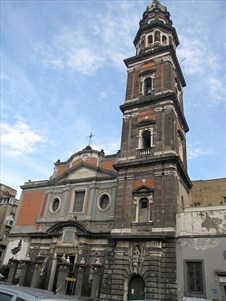Fanzago and the revolt of Masaniello
 Cosimo Fanzago was also a witness of, and, in a sense an actor in, the events that characterized the so-called revolt of Masaniello (1647-48). The popular uprising, led at first by the charismatic figure who gave it its name, the fishmonger Tommaso Aniello called Masaniello, caught the viceroy Rodrigo Ponce de León, the Duke of Arcos by surprise. On 13 July 1647 the rebels decided to sculpt the rights of the people and the provisions agreed to by the viceroy in an epitaph in the Market Square (photo: Church of Santa Maria del Carmine Maggiore). It was the viceroy himself, at the request of Masaniello, who commissioned the work to Fanzago. The Epitaph of the market was to be accompanied by the statues of the King of Spain and Naples, Philip IV, the patron of the work and Cardinal Ascanio Filomarino, another key figure in the early months of the uprising. The work remained incomplete, however, because the progression of events forced Fanzago to flee from Naples and go to Rome several times in subsequent years. After Masaniello’s killing and the escape of the Duke of Arcos, the revolt spread to the provinces of the kingdom, despite the increasingly obvious divisions among the insurgents. The naval bombardment of the city by the Spaniards led to the proclamation of the Republic (October 1647). In the following months the Madrid government exploited the divisions of the revolutionary front and recaptured Naples (April 1648), while in the countryside the barons undertook a harsh crackdown. During the uprising, several works by Fanzago, as in the case of Palazzo Donn’Anna, suffered serious damage. The Epitaph of the market was demolished in the nineteenth century.
Cosimo Fanzago was also a witness of, and, in a sense an actor in, the events that characterized the so-called revolt of Masaniello (1647-48). The popular uprising, led at first by the charismatic figure who gave it its name, the fishmonger Tommaso Aniello called Masaniello, caught the viceroy Rodrigo Ponce de León, the Duke of Arcos by surprise. On 13 July 1647 the rebels decided to sculpt the rights of the people and the provisions agreed to by the viceroy in an epitaph in the Market Square (photo: Church of Santa Maria del Carmine Maggiore). It was the viceroy himself, at the request of Masaniello, who commissioned the work to Fanzago. The Epitaph of the market was to be accompanied by the statues of the King of Spain and Naples, Philip IV, the patron of the work and Cardinal Ascanio Filomarino, another key figure in the early months of the uprising. The work remained incomplete, however, because the progression of events forced Fanzago to flee from Naples and go to Rome several times in subsequent years. After Masaniello’s killing and the escape of the Duke of Arcos, the revolt spread to the provinces of the kingdom, despite the increasingly obvious divisions among the insurgents. The naval bombardment of the city by the Spaniards led to the proclamation of the Republic (October 1647). In the following months the Madrid government exploited the divisions of the revolutionary front and recaptured Naples (April 1648), while in the countryside the barons undertook a harsh crackdown. During the uprising, several works by Fanzago, as in the case of Palazzo Donn’Anna, suffered serious damage. The Epitaph of the market was demolished in the nineteenth century.
